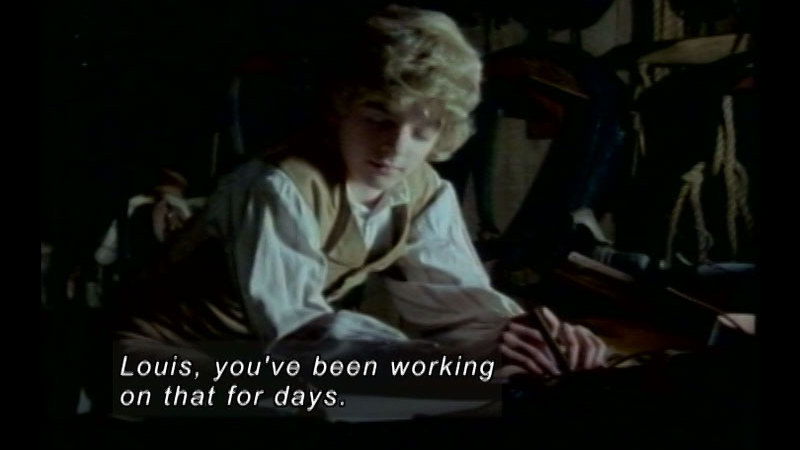<< Learning Center
Media Accessibility Information, Guidelines and Research
Young Heroes: Louis Braille Resource Guide

Introduction
The DCMP is pleased to present the short film Young Heroes: Louis Braille, available with description and—for the first time—captions.
DCMP members: Click here to view.
Non-members: Click here to view on DCMP's YouTube Channel.
Follow the story of Louis, from the accident in his hometown of Coupvray, France that led to his blindness at the age of 3, to his scholarship at the Royal Institution for Blind Youth in Paris, to the development of his famous 6-dot code, which led to a revolution in communication for people who are blind and an eventual posthumous honor: burial in the Pantheon in Paris.
Today, Braille’s code is used in hundreds of languages by people all over the world. The original slate and stylus have evolved to personal hand-held electronic braille notetakers, and the large volumes of embossed paper have been partially supplanted by refreshable braille displays connected to computers and other electronic equipment. Though the number of children who are blind and braille readers has dwindled in recent years], Louis Braille’s innovative system continues—to this day—its contribution to literacy for people who are blind.
Catalog Description
Dramatizes the life of Louis Braille, including the events that caused him to become blind as well as the cause of his death in 1852 at the age of 43 of tuberculosis. Illustrates the development of the Braille System, which he created in 1824 at the age of 15, and how it was at first rejected and even banned at the Royal Institute for Blind Youth (where Braille attended as a child and was later employed as a teacher).
Produced by Protocol Entertainment, Inc. | 1998 | 35 minutes | Grades 7–12
Additional Information and Trivia for Teachers
- Louis, also an accomplished pianist and organist, adapted his braille code for musical transcription; his friend Gabriel Gauthier was among the first to learn how to read music in braille.
- Andre Pigner who, in the Young Heroes film, was depicted as Dufau’s assistant at the Institute, was actually his predecessor. Also, the “competition” between Barbier’s nocturnal writing and Louis’ 6-dot code was an adaptation of a demonstration of braille given to the public at the dedication of the new Institute building in 1843 and was led, incidentally, by Dufau, who had since been convinced by his assistant (and self-interest, given the popularity of the code) to support Louis’ efforts.
- The first braille textbook—a 3-volume history of France—was transcribed by the students at the Institute in 1837.
- Along with the reasoning that Dufau provides in the film for opposing the adoption of Braille’s code (i.e., that sighted teachers would lose their jobs if people who are blind became too independent), other teachers complained about the distractions caused by the sound of students embossing the dots on their slates, while others were offended that they’d have to learn to read a language that did not resemble traditional printed language.
- The actual differences between Braille’s 6-dot code and Barbier’s nocturnal writing include the following: braille includes punctuation, musical notes, numbers, and structural elements, none of which were included in nocturnal writing; braille is based on the printed alphabet, while nocturnal writing’s elements were representations of 36 basic sounds; braille is confined to three rows of two dots, arranged vertically, while nocturnal writing encompassed up to 12 dots and dashes, which were far too many to be easily read with a single fingertip. Most of these differences were detailed in the Young Heroes video.
- Braille and his friends Gabriel Gauthier and Hippolyte Coltat became the first blind teachers at the Institute in the early 1830s.
- Louis also invented raphigraphy, a system by which braille dots were arranged to resemble large printed letters. Originally developed to enable other students at the Institute to send letters to their relatives, raphigraphy was popular in Europe until mass production of the typewriter began in the 1870s.
- Because Braille was not the momentous celebrity in life that he was years after his death, there are no actual photographs of him in existence. However, when he died, a daguerreotype photo was taken that has become the basis for nearly every modern rendering of Louis.
Related Media
Browse described and captioned videos under the topic of Blindness.
Related Learning Center Resources
Blindness and Black History: One Leader's Perspective
Sources For More Information About Louis Braille and His Code
- Louis Braille on Wikipedia
- Canadian National Institute of the Blind Foundation;CNIB also commissioned the description of “Young Heroes: Louis Braille”)
- Louis Braille [DOC] from the Royal National Institute of Blind People (RNIB) in the U.K.
Tags:
Please take a moment to rate this Learning Center resource by answering three short questions.
